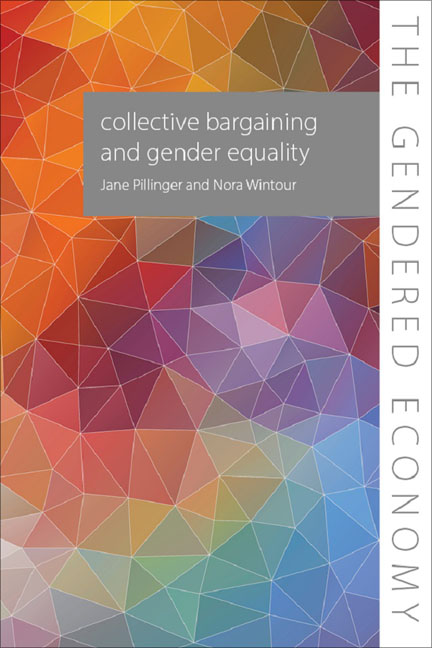Book contents
- Frontmatter
- Dedication
- Contents
- Acknowledgements
- Acronyms
- Foreword
- 1 Introduction
- 2 The gender dimensions of collective bargaining
- 3 Collective bargaining as a tool for gender equality: evidence from across the world
- 4 Changing employment patterns, precarious and informal work, and the challenge for collective bargaining
- 5 The global dimension of collective bargaining: the role of global framework agreements in promoting gender equality
- 6 Conclusion
- References
- Index
3 - Collective bargaining as a tool for gender equality: evidence from across the world
Published online by Cambridge University Press: 09 August 2023
- Frontmatter
- Dedication
- Contents
- Acknowledgements
- Acronyms
- Foreword
- 1 Introduction
- 2 The gender dimensions of collective bargaining
- 3 Collective bargaining as a tool for gender equality: evidence from across the world
- 4 Changing employment patterns, precarious and informal work, and the challenge for collective bargaining
- 5 The global dimension of collective bargaining: the role of global framework agreements in promoting gender equality
- 6 Conclusion
- References
- Index
Summary
Collective bargaining can ensure the systematic integration of gender dimensions into labour market and macroeconomic policies in general, and address specific issues such as the gender pay gap, enhanced protection against discrimination, work–family measures and childcare infrastructure, sexual violence and harassment, and the promotion of female employment. (ILO 2009 Resolution concerning “Gender equality at the heart of decent work”, para. 37).
This chapter discusses three main themes that are important components of recent bargaining and collective agreements on gender equality: (1) closing the gender pay gap; (2) maternity protection, parental leave and work–life balance; and (3) gender-based violence at work. Despite the external environment leading to the decentralization and weakening of bargaining in many countries across the world, in recent years bargaining has become more gender-focused. The bargaining agenda has been extended to include new issues that reflect the intersection of the private area of family/home and the public area of work, thereby extending the scope of the employment relationship. In particular, domestic violence is a new workplace bargaining issue that “widens the reach of the employment relationship by recognizing the intersection of the private and work domains and represents a qualitative new step” (Pillinger, Schmidt & Wintour 2016).
CLOSING THE GENDER PAY GAP THROUGH COLLECTIVE BARGAINING
Collective bargaining has played a role in closing the gender pay gap, and as discussed previously, there is wide agreement that centralized bargaining generally has a positive impact on gender pay inequalities (Hayter 2011; Pillinger 2014; Ponzellini, Aumayr & Wolf 2010). A reduction in the gender pay gap from 2004 to 2008 can be attributed to three main factors: (1) working in the public sector; (2) membership of a trade union; and (3) working in a large firm (Olsen et al. 2010). The success of bargaining strategies is dependent on a range of factors (discussed in Chapter 1), as well as the level of union commitment to the issue and the proportion of women in a sector (Dawson 2018; Elvira & Saporta 2001; Rubery & Koukiadaki 2016).
However, the trend towards the individualization of pay and a lack of pay transparency makes the issue of pay inequalities between women and men complex to tackle, particularly in the context of the economic crisis and a general trend towards rising wage inequalities (Antonczyk et al. 2010).
- Type
- Chapter
- Information
- Collective Bargaining and Gender Equality , pp. 35 - 88Publisher: Agenda PublishingPrint publication year: 2018



